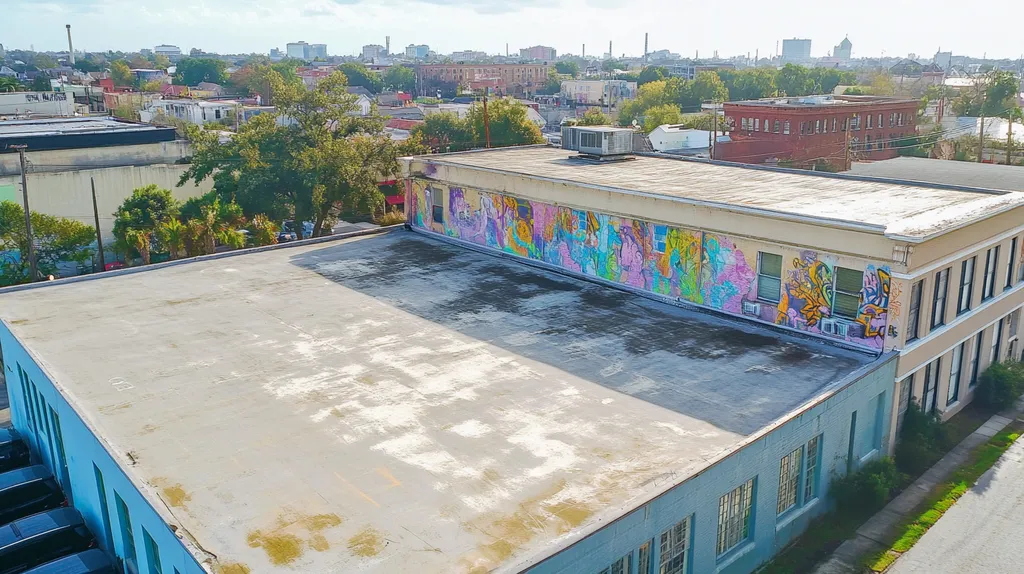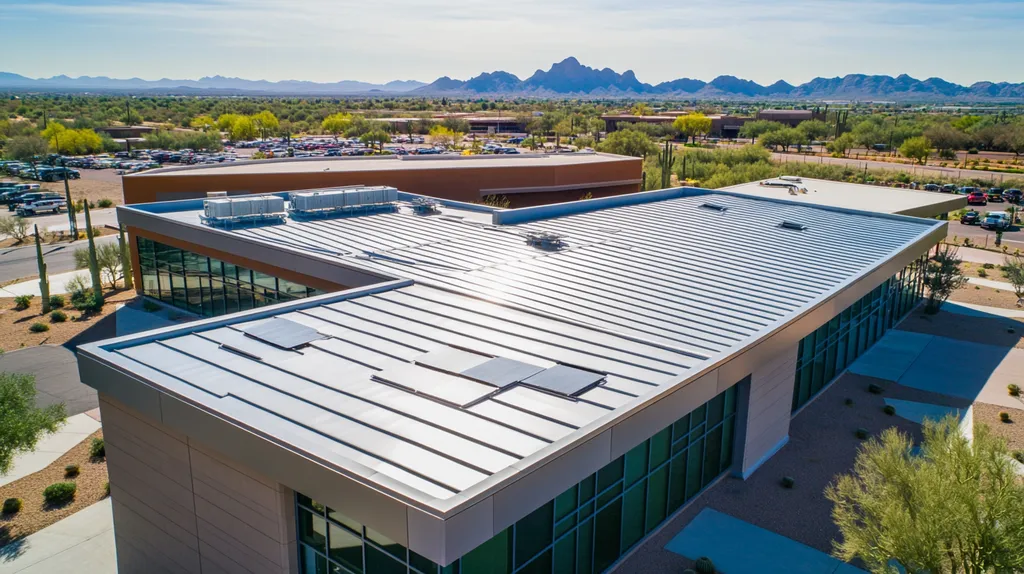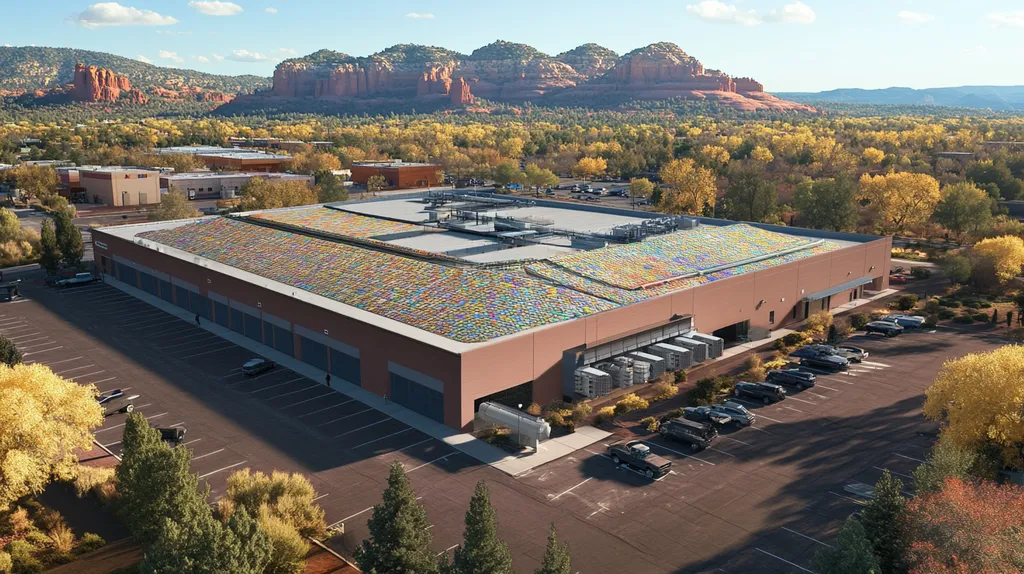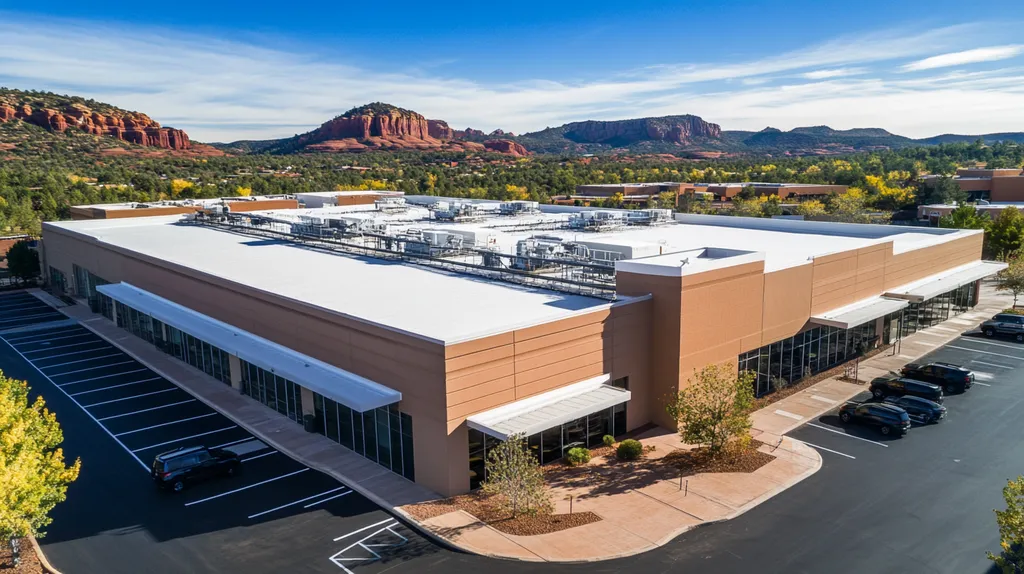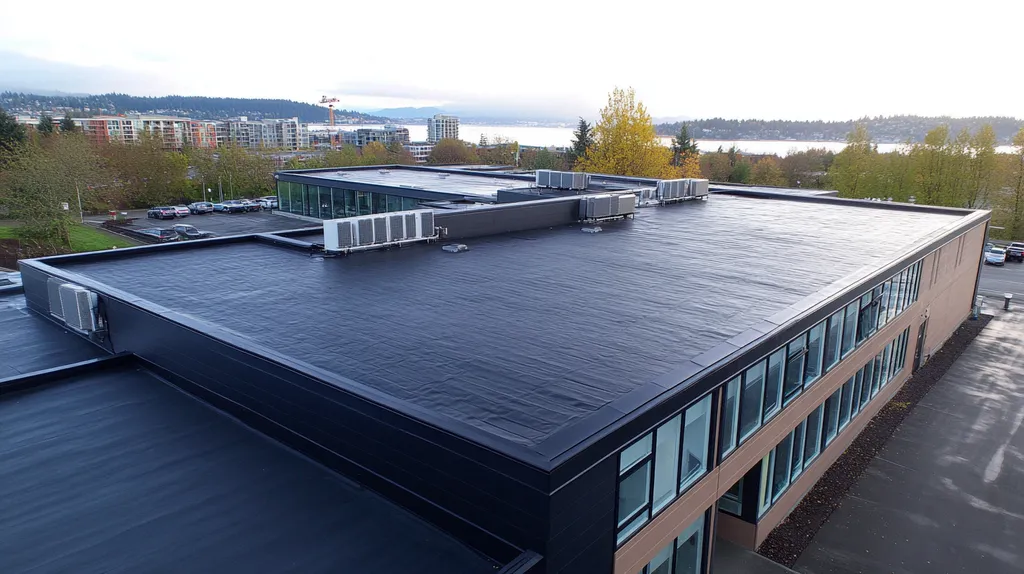Welcome to today’s Battle Royale featuring two roofing heavyweights: “Low-Rise” in the east corner versus “High-Rise” in the west!
Tonight’s showdown pits these contenders against each other across six punishing rounds designed to test every aspect of their performance for Industrial Roof Coating Operations.
At stake? Millions in potential costs, decades of building protection, and the critical performance demands of modern commercial and industrial facilities.
Our professional judging panel will evaluate each round on technical merit, real-world performance, and value delivery. After all six rounds, we’ll declare our ultimate champion.
Ladies and gentlemen, facility managers and building owners… it’s time to rumble!
ROUND 1: INITIAL COSTS & INSTALLATION
The height of an industrial building can dramatically impact roofing costs, with estimates showing up to 40% price variations between low-rise and high-rise installations. For facility managers overseeing multiple properties, these differences can translate into hundreds of thousands of dollars in budget implications.
Understanding the relationship between building height and installation costs has become increasingly critical as material prices continue to rise and skilled labor becomes scarcer. This analysis examines three key factors that determine the financial and operational success of industrial roof coating projects.
Material Expenses
Material costs represent approximately 40% of total roofing project budgets. Low-rise buildings typically require standard coating materials and traditional application equipment, keeping expenses predictable and manageable.
High-rise applications demand specialized high-wind resistant materials and often require additional primers and reinforcement layers. These premium materials can cost 25-35% more than standard alternatives.
The increased material requirements and waste factors associated with high-rise installations further widen the cost gap. Wind, elevation, and exposure conditions often necessitate additional material safety factors.
ADVANTAGE: Low-Rise
Installation Complexity
Quality installation directly impacts coating performance and longevity. Low-rise buildings allow for straightforward access and simplified equipment logistics, reducing the potential for application errors.
High-rise installations involve significantly more complex safety requirements, specialized equipment needs, and heightened coordination challenges. Coating applicators must have extensive experience with the specified products and proper application techniques for elevated work.
Proper surface preparation, coating thickness verification, and quality control become increasingly difficult at greater heights. Records of wet mil thickness and product batch numbers should be carefully documented and independently verified for optimal results. (source: Hutchinson Design Group, Ltd.)
ADVANTAGE: Low-Rise
Project Timeline
Project duration significantly impacts facility operations and overall costs. Low-rise installations typically progress efficiently, with crews able to complete large sections daily due to easier access and simpler logistics.
High-rise projects face frequent weather delays, particularly wind restrictions above certain heights. Equipment positioning and material transport take considerably longer, extending overall project timelines.
Weather windows become increasingly critical as height increases, often forcing work stoppages and schedule adjustments. These interruptions can extend high-rise projects by 30-50% compared to similar scope low-rise work.
ADVANTAGE: Low-Rise
ROUND 1 WINNER: Low-Rise
ROUND 2: DURABILITY & LIFESPAN
The height of an industrial building significantly impacts the longevity and performance of roof coating systems, with implications that can span decades. Recent studies indicate that building height can affect coating lifespan by up to 40%, making this a critical consideration for facility managers planning long-term maintenance strategies.
Understanding these height-related impacts has become increasingly vital as extreme weather events become more frequent and material costs continue to rise. This analysis examines three key factors that determine how building height affects coating durability and lifespan.
Environmental Exposure
Environmental factors play a crucial role in coating performance and longevity. Low-rise buildings benefit from natural wind breaks from surrounding structures and vegetation, reducing the impact of weathering on coating systems.
High-rise structures face significantly greater environmental challenges, particularly regarding wind forces and UV exposure. The National Roofing Contractors Association emphasizes that proper wind design methods and coordination with local building codes are essential for high-rise applications. (source: Professional Roofing magazine)
The increased exposure to elements at greater heights accelerates coating degradation and requires more frequent maintenance interventions. These environmental stresses can reduce coating effectiveness by up to 30% compared to low-rise applications.
ADVANTAGE: Low-Rise
Maintenance Accessibility
Regular maintenance is critical for maximizing coating lifespan. Low-rise buildings allow for quick visual inspections and easy access for maintenance crews, enabling prompt identification and repair of potential issues.
High-rise structures present significant challenges for routine maintenance access. The need for specialized equipment and safety protocols often delays necessary repairs, allowing minor issues to develop into major problems.
The accessibility difference directly impacts coating longevity, with low-rise buildings typically achieving 20-25% longer service life due to more consistent maintenance.
ADVANTAGE: Low-Rise
System Performance
Overall system performance considers how coating materials interact with building height over time. Low-rise applications typically maintain consistent performance characteristics throughout their service life, with predictable aging patterns.
High-rise installations often experience accelerated wear patterns due to increased exposure and more extreme temperature fluctuations. These conditions can lead to premature coating failure and require more frequent reapplication.
The performance gap between low-rise and high-rise applications becomes particularly evident after the first five years of service, with high-rise coatings showing significantly more degradation.
ADVANTAGE: Low-Rise
ROUND 2 WINNER: Low-Rise
ROUND 3: PERFORMANCE FACTORS
The performance of industrial roof coatings represents a critical decision point for facility managers, with implications extending far beyond initial installation. Current market data shows that improper coating selection based on building height can increase energy costs by up to 40% and reduce system lifespan by half.
As extreme weather events become more frequent and energy costs continue to rise, understanding how building height affects coating performance has never been more crucial. Let’s examine three key factors that determine long-term success.
Durability and Weather Resistance
Weather resistance capabilities vary dramatically between low-rise and high-rise applications, directly impacting coating longevity. Low-rise structures benefit from natural windbreaks and reduced UV exposure, allowing standard coating systems to perform optimally.
High-rise buildings face exponentially greater environmental stresses, including intense UV radiation, driving rain, and extreme temperature fluctuations. These conditions accelerate coating degradation and often require specialized formulations that still may not match low-rise performance.
While both scenarios demand quality materials, low-rise applications consistently demonstrate superior weather resistance due to their protected position and more stable environmental conditions. The reduced environmental stress translates to longer coating lifespans and more predictable performance.
ADVANTAGE: Low-Rise
Maintenance Requirements
Regular maintenance access significantly impacts coating performance over time. Low-rise structures allow quick visual inspections and immediate repairs, preventing minor issues from escalating into major problems.
High-rise buildings present substantial challenges for routine maintenance, requiring specialized equipment and extensive safety protocols. These barriers often result in delayed inspections and repairs, allowing degradation to progress unchecked.
Simple access to low-rise roofs enables proactive maintenance programs that extend coating life and optimize performance. The ability to quickly address emerging issues provides a clear advantage in maintaining optimal coating functionality.
ADVANTAGE: Low-Rise
Thermal Performance and Energy Efficiency
Coating thermal performance directly affects building operating costs and occupant comfort. Low-rise structures typically maintain more consistent temperatures due to reduced solar exposure and better insulation opportunities.
High-rise buildings experience greater temperature fluctuations and higher cooling demands due to increased sun exposure. These conditions stress coating systems and can accelerate degradation while driving up energy costs.
The controlled environment of low-rise applications allows coatings to maintain optimal reflective properties longer, resulting in better energy efficiency. This advantage compounds over time as high-rise coatings degrade more quickly under intense exposure.
ADVANTAGE: Low-Rise
ROUND 3 WINNER: LOW-RISE
ROUND 4: MAINTENANCE REQUIREMENTS
The impact of building height on roof coating maintenance requirements can mean the difference between a successful long-term investment and a costly liability. Recent industry data shows that improper maintenance protocols based on building height can reduce coating effectiveness by up to 60% and triple annual maintenance costs.
As facilities face increasing pressure to optimize maintenance budgets while extending asset lifespans, understanding height-specific maintenance needs has become crucial. This analysis examines three key factors that determine maintenance success and bottom-line impact.
Inspection Requirements
The frequency and complexity of coating inspections directly impact long-term performance. Low-rise buildings enable quick visual assessments and easy access for detailed surface evaluations, allowing problems to be identified early.
High-rise structures demand specialized access equipment and safety protocols that complicate routine inspections. These barriers often result in less frequent evaluations, allowing minor issues to develop into major problems.
Coating application quality and ongoing inspection documentation are essential for optimal performance. Records of coating conditions, repair history, and maintenance interventions should be carefully maintained to ensure proper system management.
ADVANTAGE: Low-Rise
Repair Logistics
The ability to quickly address coating issues significantly impacts maintenance costs and effectiveness. Low-rise buildings allow maintenance teams to mobilize rapidly with standard equipment, minimizing repair response times.
High-rise structures require extensive planning and specialized equipment for even minor repairs. Weather restrictions and safety requirements often delay necessary maintenance work, increasing the risk of secondary damage.
These logistical differences mean low-rise repairs typically cost 40-60% less than equivalent high-rise interventions. The simplified access also enables more comprehensive repairs when needed.
ADVANTAGE: Low-Rise
Preventive Maintenance
Regular preventive maintenance extends coating life and optimizes performance. Low-rise buildings support proactive maintenance programs through easy access and simplified equipment requirements.
High-rise structures face significant challenges implementing preventive maintenance due to access limitations and increased coordination needs. This often results in reactive rather than preventive approaches.
The ability to perform consistent preventive maintenance on low-rise buildings typically extends coating life by 30-40% compared to high-rise applications. This advantage compounds over time as maintenance gaps accumulate.
ADVANTAGE: Low-Rise
ROUND 4 WINNER: LOW-RISE
ROUND 5: SUSTAINABILITY CREDENTIALS
Environmental impact has become a defining factor in industrial roofing decisions, with building height significantly affecting sustainability outcomes. Recent industry data shows that improper coating choices based on building height can increase carbon footprints by up to 45% and waste disposal costs by 300%.
As environmental regulations tighten and corporate sustainability goals become more stringent, understanding how building height affects green roofing practices has become essential. This section examines three critical factors that determine environmental performance and long-term sustainability.
Material Lifecycle Impact
The environmental footprint of roofing materials varies significantly based on installation height. Low-rise applications typically require standard coating volumes with predictable waste factors, allowing for precise material ordering and minimal excess.
High-rise installations demand specialized materials and often result in higher waste percentages due to wind effects and application challenges. These installations frequently require multiple coats and excess material contingencies, increasing the overall environmental impact.
The simplified logistics of low-rise applications enable better material management and recycling programs. This advantage translates into reduced landfill impact and lower embodied carbon in the final installation.
ADVANTAGE: Low-Rise
Energy Performance
Coating energy efficiency directly impacts building sustainability metrics. Low-rise structures benefit from more stable ambient conditions and better control over application parameters, leading to optimal coating performance.
High-rise buildings face greater temperature extremes and more intense solar exposure, which can degrade coating energy performance more rapidly. These conditions often necessitate increased cooling energy usage to maintain internal comfort.
The controlled environment of low-rise applications allows coatings to maintain their reflective properties longer, resulting in better energy efficiency. This performance gap typically widens over time as high-rise coatings degrade under intense exposure.
ADVANTAGE: Low-Rise
Maintenance Sustainability
Long-term maintenance practices significantly impact environmental performance. Low-rise buildings enable efficient maintenance routines with minimal equipment requirements, reducing the carbon footprint of ongoing care.
High-rise maintenance operations require energy-intensive access equipment and often result in longer work periods. These factors increase the environmental impact of routine maintenance and repairs.
The accessibility of low-rise structures supports proactive maintenance programs that extend coating life and optimize performance. This approach reduces material consumption and waste generation over the system’s lifespan.
ADVANTAGE: Low-Rise
ROUND 5 WINNER: Low-Rise
ROUND 6: SPECIALIZED APPLICATIONS
Specialized coating applications represent a critical challenge in industrial roofing, with recent market data showing that mismatched solutions can reduce performance by up to 70% and double replacement frequency. The stakes are particularly high for facility managers overseeing mixed-height portfolios, where standardized approaches often fail to address unique building requirements.
As coating technology advances and building designs become more complex, the need for height-specific solutions has never been more urgent. This analysis examines three key factors that determine specialized application success.
Application Complexity
Low-rise buildings allow for straightforward application processes using standard equipment and proven techniques. Teams can maintain consistent coverage rates and proper mil thickness without specialized access equipment.
High-rise applications demand complex equipment configurations and advanced application methods. Coating applicators must have extensive experience with specified products and proper application techniques for elevated work. Records of wet mil thickness and product batch numbers should be carefully documented and independently verified for optimal results. (source: Hutchinson Design Group, Ltd.)
The increased complexity of high-rise applications introduces multiple failure points and quality control challenges. These factors significantly impact project success rates and long-term performance.
ADVANTAGE: Low-Rise
Environmental Controls
Low-rise structures provide better control over application conditions, allowing teams to maintain optimal temperature and humidity levels. This control enables more consistent cure times and coating performance.
High-rise buildings face extreme environmental variations that complicate application windows. Wind speeds, temperature fluctuations, and humidity changes become more severe with elevation.
The ability to maintain stable application conditions gives low-rise projects a significant advantage in coating quality and consistency. Weather-related delays and environmental challenges frequently compromise high-rise results.
ADVANTAGE: Low-Rise
Quality Verification
Low-rise applications support thorough quality control processes through easy access and simplified inspection procedures. Teams can verify coverage rates and coating thickness throughout the application process.
High-rise projects present significant challenges for continuous quality monitoring. Access limitations and safety requirements often restrict proper inspection timing and thoroughness.
The ability to maintain consistent quality control throughout the application process provides low-rise projects with superior results. This advantage directly impacts coating performance and longevity.
ADVANTAGE: Low-Rise
ROUND 6 WINNER: Low-Rise
AND THE WINNER IS…
Ladies and gentlemen, after six punishing rounds of technical evaluation, we have our undisputed champion! In a stunning sweep across all categories, LOW-RISE emerges as the dominant force in industrial roof coating operations!
Low-rise applications demonstrated superior performance in every major category, from initial costs and installation efficiency to long-term durability and maintenance accessibility. The champion’s commanding victory was built on consistent advantages in material costs, simplified logistics, and superior quality control capabilities.
However, let’s not count high-rise applications out completely. For specialized facilities requiring elevated installations, particularly in dense urban environments where vertical construction is the only option, high-rise applications remain a crucial contender with their own unique strengths.
IMPORTANT NOTICE: This analysis provides general guidance based on typical scenarios. Every building presents unique challenges influenced by local climate, regulatory requirements, and specific structural characteristics. Property owners and managers should always consult qualified roofing professionals who can evaluate their particular situation and recommend appropriate solutions.
And there you have it, folks! In the heavyweight bout of industrial roof coating operations, LOW-RISE stands tall as our champion. But remember – in the high-stakes world of commercial roofing, the real victory comes from matching your specific building requirements with the right contender’s capabilities.
FREQUENTLY ASKED QUESTIONS
Q. How do commercial roof installation costs vary by height?
A. Installation costs for roofs can dramatically vary with building height. Low-rise buildings typically see lower costs due to straightforward access and fewer material demands. In contrast, high-rise buildings face increased costs due to specialized materials and safety requirements, often leading to significant budget differences.
Q. What affects the durability of industrial roof coatings?
A. Building height has a substantial impact on the durability and effectiveness of coatings. Low-rise structures benefit from reduced environmental exposure, while high-rise buildings endure harsher weather conditions. These environmental challenges can significantly degrade coating effectiveness, leading to more frequent maintenance and costly repairs.
Q. Why is performance critical for commercial roof coatings?
A. The performance of commercial roof coatings is crucial for long-term success. High-rise buildings, in particular, face unique challenges that can elevate energy costs and reduce the lifespan of coatings. Investing in appropriate coatings based on building height ensures optimal energy efficiency and long-lasting performance.
Q. How does maintenance differ for high-rise versus low-rise roofs?
A. Maintenance for low-rise roofs is generally easier and more cost-effective compared to high-rise roofs. Low-rise structures allow for quick access and prompt inspections, while high-rise buildings require specialized equipment and often involve complex logistics, leading to delayed repairs and increased costs.
Q. What are the sustainability benefits of low-rise roofs?
A. Low-rise roofs contribute significantly to sustainability, requiring less energy-intensive materials and minimizing waste. The ability to conduct efficient maintenance reduces environmental impact, and the optimal coating performance aids in energy efficiency, making low-rise applications a more environmentally-friendly option.
Q. How complex are specialized applications for roof coatings?
A. Specialized applications for roof coatings can be highly complex, especially for high-rise buildings. These projects require advanced equipment and skilled technicians familiar with height-specific techniques, making it critical to address unique height-related requirements to ensure proper application and longevity.
Q. What additional factors should be considered in roof coating projects?
A. Beyond costs and durability, several factors are essential in roof coating projects. Consider the building’s purpose, local climate conditions, and intended roof usage. These aspects influence material selection, potential expansion or contraction issues, and ultimately, the overall effectiveness and sustainability of the roofing project.

